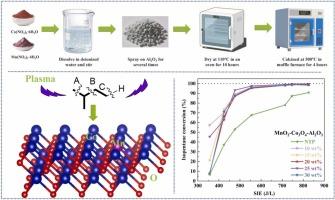非热等离子体和锰基催化剂协同转化异戊烷:机理和效率提高的见解
IF 6.3
2区 材料科学
Q2 CHEMISTRY, PHYSICAL
引用次数: 0
摘要
本研究探讨了将非热等离子体(NTP)与催化相结合作为VOCs降解的有效解决方案。具体而言,合成了MnO2-Co3O4-Al2O3催化剂,并对其降解异戊烷的能力进行了测试。实验结果表明,NTP与催化剂的耦合作用显著提高了异戊烷的转化率,达到99%的异戊烷转化率和72.6%的矿化率,同时将臭氧(O3)排放量抑制在1 μL/L以下。此外,能源利用效率大幅提高,最高效率达到400克千瓦时-1。理论计算和现场实验结果表明,丙酮是异戊烷降解的关键中间产物,其生成和氧化是异戊烷矿化的关键步骤。Mn-Co掺杂使·OH和10o2的形成势垒降低到2.8 ~ 3.5 eV,有利于丙酮中间体的生成和C-C键的裂解。本研究建立了氧空位工程和等离子体-催化剂协同的双重策略,以有效消除挥发性有机化合物。本文章由计算机程序翻译,如有差异,请以英文原文为准。

Synergistic Conversion of Isopentane by Non-Thermal Plasma and Mn-based Catalysts: Insights into Mechanisms and Efficiency Enhancement
This study explores the use of non-thermal plasma (NTP) coupled with catalysis as an effective solution for VOCs degradation. Specifically, MnO2-Co3O4-Al2O3 catalysts were synthesized and tested for their ability to degrade isopentane. Experimental results demonstrated that the coupling of NTP with the catalyst significantly enhanced isopentane conversion, which can reach 99% isopentane conversion and 72.6% mineralization rate, while suppressing Ozone (O3) emissions to <1 μL/L. Furthermore, the energy utilization efficiency was substantially improved, achieving a maximum efficiency of 400 g kWh-1. Theoretical calculations and in-situ experiment reveal that acetone is the key intermediate product in the degradation of isopentane, and its formation and oxidation are essential steps for the mineralization of isopentane. Mn-Co doping lowers the formation barriers of ·OH and 1O2 to 2.8-3.5 eV, thus facilitating acetone intermediate generation and C-C bond cleavage. This work establishes a dual strategy of oxygen-vacancy engineering and plasma-catalyst synergy for efficient VOCs elimination.
求助全文
通过发布文献求助,成功后即可免费获取论文全文。
去求助
来源期刊

Journal of Alloys and Compounds
工程技术-材料科学:综合
CiteScore
11.10
自引率
14.50%
发文量
5146
审稿时长
67 days
期刊介绍:
The Journal of Alloys and Compounds is intended to serve as an international medium for the publication of work on solid materials comprising compounds as well as alloys. Its great strength lies in the diversity of discipline which it encompasses, drawing together results from materials science, solid-state chemistry and physics.
 求助内容:
求助内容: 应助结果提醒方式:
应助结果提醒方式:


